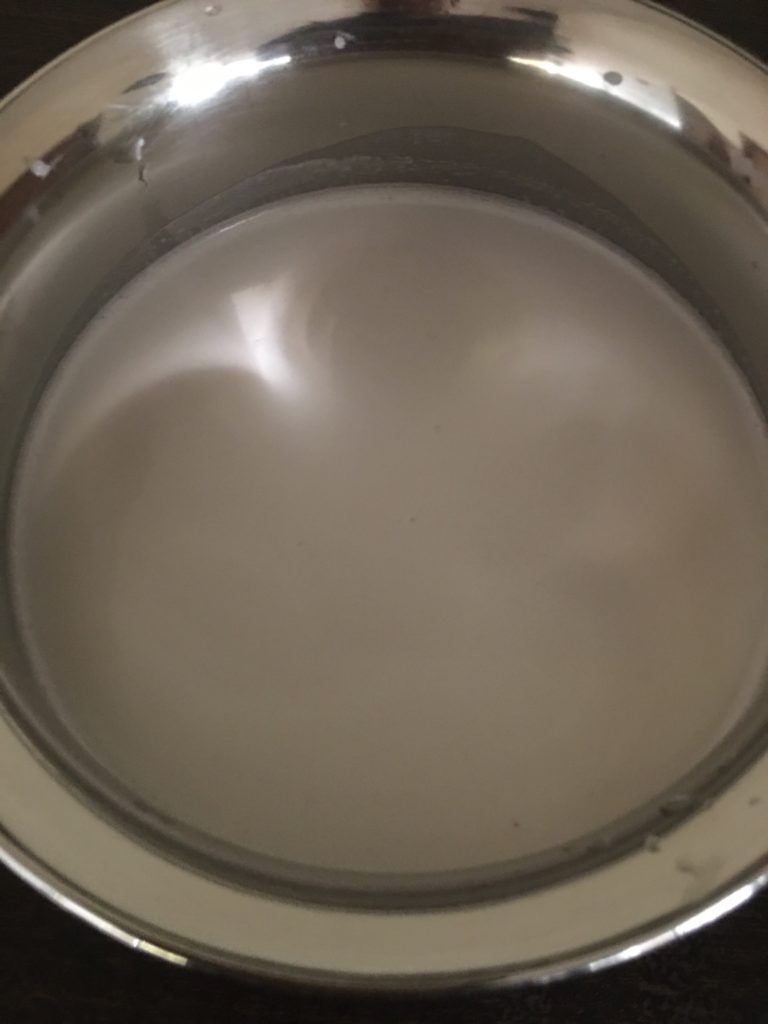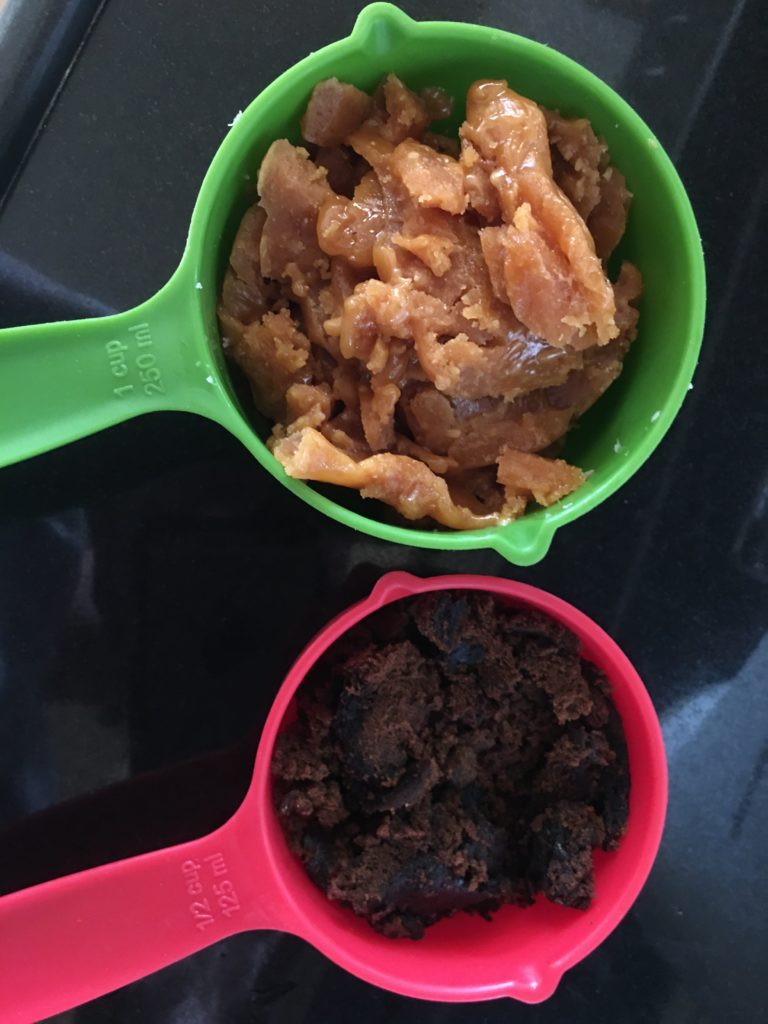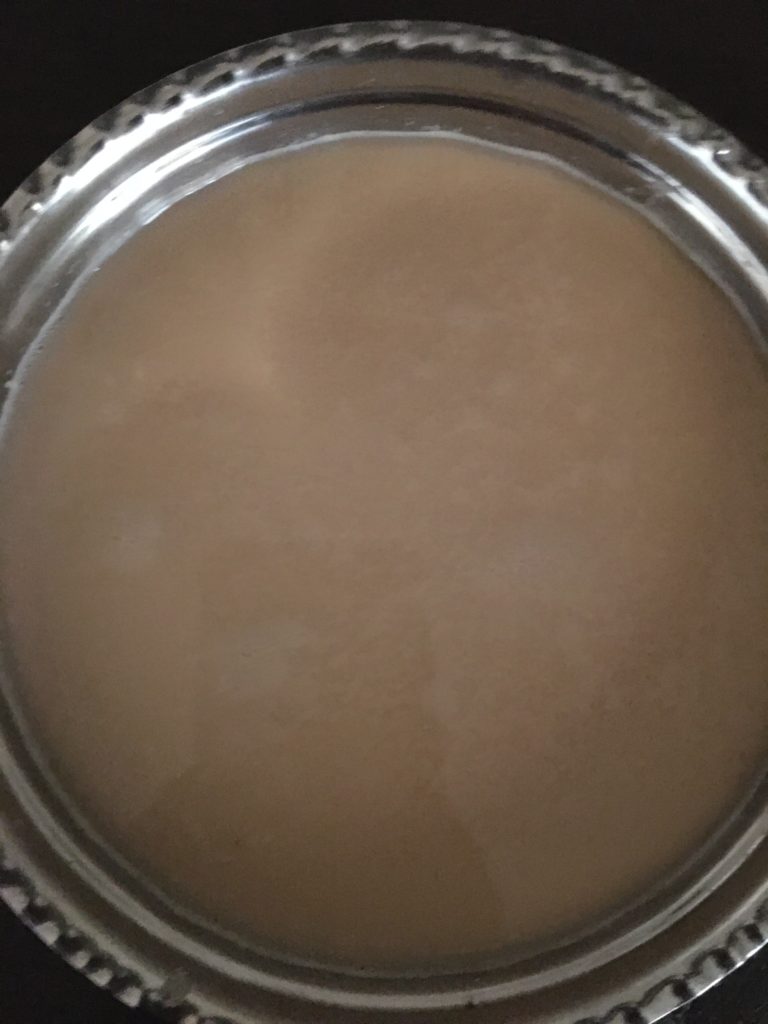Nachni Satva, Nachni Kapa or Ragi Pudding is a sweet dessert prepared using ragi extract, coconut milk and jaggery. You can add cashewnuts and cardamom powder to enhance taste and flavour. Kids can eat this as a snack after school or after playtime. Ragi is one of the most nutritious and healthy cereals.

‘Kapa’ means pieces in Konkani. Ragi extract is used to prepare nachni kapa. It is combined with coconut milk and jaggery and cooked to form a slurry. This slurry hardens after cooling like pudding. You can cut the pudding into pieces. I have used regular jaggery and partly ‘coconut jaggery‘. Coconut jaggery imparts a nice flavour and a deep brown chocolate colour to it. You can vary the proportions as per your taste.
What is Nachni or Ragi?
Nachni or Ragi is known as ‘finger millet‘ in English. Its scientific name is ‘Eleusine coracana‘. They are tiny red seeds that closely resemble mustard. People in Goa, Maharashtra and Karnataka widely consume nachni. In India, finger millet is commonly known by various names like Ragi (in Kannada, Telugu and Hindi), Mandua/Mangal in Hindi, Kodra (Himachal Pradesh), Mandia (Oriya), Taidalu (in Telangana region), Kezhvaragu in Tamil etc. Given to toddlers, lactating women, convalescing patients ragi aids in the process of growth and healing. That’s why its considered a ‘superfood’ in its own right.
Health benefits of Ragi
Ragi porridge is a very nourishing drink as it is rich in iron and calcium. Of all the cereals and millets, finger millet has the highest amount of calcium (344mg%) and potassium (408mg%). No wonder it is called the ‘poor man’s milk’ as it comes at a very affordable price. It is gluten-free. Finger millet is safe for people having gluten allergy and celiac disease. It is easy to digest. Hence, it is recommended as weaning food for small babies.
What to use Ragi Seeds or Ragi Flour?
It depends on what you prepare. Preferably, it eaten in the form of porridge also known as ‘satva‘ in Konkani. Seeds are used usually to prepare porridge, kapa, dosa wheres flour is used to prepare bhakris (similar to rotis), instant dosas etc.
How to make Nachni Satva/Kapa?
- Take 1 cup of nachni or finger millet in a bowl. Wash it with water a couple of times till it is clean. Soak it for 5-6 hours.

2. Grind the nachni in a mixie to get a smooth and fine paste. Use little water while grinding.

3. Add 1 cup water to this paste and extract juice using a fine sieve strainer. Add a little more water to the residue to extract any leftover juice. Discard the residue.

4. Keep this juice aside covered for about an hour to let the ‘satva’ settle down.
Extracting Coconut milk
5. Grind 1 cup grated coconut with a little water to a fine paste.
6. Extract coconut milk using a strainer. Add little water to the residue to extract any extra coconut milk. Discard this residue also.

7. Add jaggery to the coconut milk and keep aside. I have used 1 cup regular jaggery and 1/2 cup coconut jaggery (also called ‘madache god’ in Konkani in Goa.) You can use 1 and 1/2 cup of regular jaggery or vary proportions to your taste.

8. After about an hour the nachni satva will settle at the bottom. Slowly discard the water above it.

9. The satva will look like this once you drain the water. It will be thick in consistency.

Making Nachni Satva
10. In a thick bottomed pan, take the ragi extract, coconut milk and jaggery mixture; and mix well to combine. Add a pinch of salt.

11. Keep the pan on medium flame and keep stirring continuously. After sometime you will see small lumps forming in the mixture. Keep stirring to avoid large lumps forming. Use a whisk to stir, as it breaks the lumps and stirring becomes very easy. Add cashewnuts (optional) at this stage.

12. It will thicken further and small bubbles of steam will start escaping from the slurry. Be careful as it might splutter on your hand. Keep the flame low and keep stirring. Add a tbsp of ghee to give it a nice glaze.

13. After about 15-20 mins the steam bubbles will stop. Switch off the gas, add cardamom powder(optional) and mix well. Pour the mixture in the greased thali. Apply some ghee to the base of a steel cup (vati or katori) and gently spread the mixture in the thali.

14. Allow it to cool. Once cooled, cut into square or diamond shaped pieces.

Nachni Kapa |Ragi Halwa|Ragi Pudding
Cuisine: IndianDifficulty: Medium6
people30
minutes20
minutes5
minutes55
minutesRagi extract combined with coconut milk and jaggery and cooked to form a halwa that can be cut into pieces.
Ingredients
1 cup=250 ml
Nachni/Ragi – 1 cup
Grated Coconut – 1 cup
Jaggery – 1 and 1/2 cup (see notes)
Salt – 1 pinch
Cashewnuts – 10-15 nos. (broken into small pieces) optional
Cardamom powder – 1/4 tsp (optional)
Ghee – 1 tbsp + 1 tsp (for greasing)
Directions
- Grease a flat-bottomed steel plate with a tsp of ghee.
- Wash nachni in water a couple of times till it is clean. Soak nachni for 5-6 hours.
- Grind the nachni with a little water till you get a smooth and fine paste. Add 1 cup water to the paste and strain the nachni through a fine sieve strainer and extract the juice.
- Again, add a little more water to the residue to extract any leftover juice. Discard the residue. Keep this juice aside covered for about an hour to let the ‘satva’ settle down.
- Meanwhile, grind coconut with water to a fine paste. Extract coconut milk using a strainer. Add little water to the residue to extract any extra coconut milk. Discard this residue also.
- Add jaggery to this and keep it aside.
- After about an hour the nachni satva will settle at the bottom. Slowly discard the water above it.
- In a thick bottomed pan, take the ragi extract, coconut milk and jaggery mixture; and mix well to combine. Add a pinch of salt.
- Keep the pan on medium flame and keep stirring continuously. After sometime you will see small lumps forming in the mixture. Keep stirring to avoid large lumps forming. Use a whisk to stir, as it breaks the lumps and stirring becomes very easy. Add cashewnuts at this stage.
- It will thicken further and small bubbles of steam will start escaping from the slurry. Be careful as it might splutter on your hand. Keep the flame low and keep stirring. Add a tbsp of ghee to give it a nice glaze.
- After about 15-20 mins the steam bubbles will stop. Switch off the gas, add cardamom powder and mix well.
- Slowly pour the mixture in the greased thali. Apply some ghee to the base of a steel cup (vati or katori) and gently spread the mixture in the thali. Allow it to cool.
- Once cooled, cut into square or diamond shaped pieces.
Notes
- I have used 1 cup regular jaggery and 1/2 cup coconut jaggery. This gives a nice dark colour and a distinct taste and flavour to the kapa. Coconut jaggery or ‘madache god‘ as it is called in Goa is available at most of the grocery stores.
- It is very important to rest the ragi juice and separate the extract and water else it take a long time for the water content to evaporate and thicken the mixture.
- Using a whisk makes stirring easy and prevents burning at the bottom.






